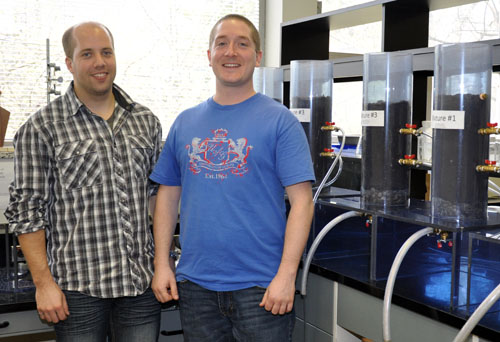
If those evergreens lining the highway look more brown than green, you’ve witnessed the effects of road salts on trees. It turns out that the salt of the Earth harms the Earth when it ends up in the wrong place – and trees aren’t the only living things that suffer from exposure to road salts.
“They’re harmful to our fish and our plants and, in terms of us, they’re harmful for our drinking water,” says Andrew Betts, a master’s student in water resource engineering. “If you look at ocean water and wonder why we don’t use it as drinking water, it’s because we can’t cost-efficiently remove salts. What we’re doing to our drinking water is that we’re slowly converting it into a saline environment. We’re turning our freshwater into salt water.”
As part of a research project funded by the Ministry of Transportation and the Ontario Research Fund, Betts is using geographic information system (GIS) data to identify areas near highways that are sensitive to road salt contamination. High-risk areas include habitats for endangered species and groundwater recharge locations, where rainwater seeps through the soil and replenishes the groundwater supply.
His case studies include the Hanlon Creek in Guelph and Highland Creek in Toronto. The goal is to develop ways to protect these and other sensitive areas throughout Ontario.
Road salts have been used since the 1960s, but it wasn’t until 2004 that Environment Canada developed application guidelines. Betts isn’t advocating a ban on road salts. “We know that we’re going to use them, so let’s try to prevent as much harm as possible,” he says. “Let’s find out where road salts are causing the most harm and let’s do something about it.”
Parking lots are more heavily salted than roads, he adds, because they fall outside of government supervision. Parking lots can have as much as 10 times more salt applied to them than roads due to concerns about lawsuits from people who might slip and fall on ice. Betts says a little road salt goes a long way in preventing accidents.
Rainfall causes road salts to dissolve into a “high chloride concentration brine mixture that washes off the road into the ditches,” he says. That salty runoff causes a short-term peak in chloride levels in the water that can harm plants and other aquatic life. One solution is to line ditches near sensitive areas with high-density polyethylene liners used in landfills to prevent road salts from seeping through.
Another option is to add materials to the soil in ditches that can temporarily adsorb the salt to reduce peak concentrations. Bill Trenouth, a PhD candidate in engineering, is studying by-products from coal mines, steel mills, and the pulp and paper industry for their ability to retain salt.
“All these types of amendments are cheap and are traditionally considered to be waste products and are locally available,” he says. “We’re trying to reuse them in some capacity so we can temporarily adsorb and hold onto those chlorides as they move through the surface waters and control their migration so we don’t get this rapid spread of these chloride plumes.”
He is developing a model ditch to contain road salts. A liner prevents salt from leaking into the groundwater, and a reservoir collects brine and controls its discharge. The ditch surface is covered with 30 cm of topsoil, which will be used to grow salt-tolerant or salt-accumulating plants, known as halophytes, found in semi-arid and prairie regions.
“Within that 30-centimetre layer of soil is where we would theoretically add some of those amendments,” says Trenouth. “We would mix them into the soil, so as the briny solution is infiltrating through that 30-centimetre layer, we would get some enhanced attenuation of the chloride plumes because we have the amendments ionically grabbing onto those chlorides.”
Alternatives to road salts are available but they’re more expensive. Pre-wetting roads with a brine solution before ice forms helps road salts stick to the surface instead of rolling off into ditches.
“From a public safety perspective, you can’t just stop using these salts, because you’re going to put millions of people’s lives at risk,” says Trenouth. “We’re not advocating that we phase them out or get rid of them altogether. What we’re advocating is responsible use and controlled application and considering other alternatives in some of the most sensitive areas.”